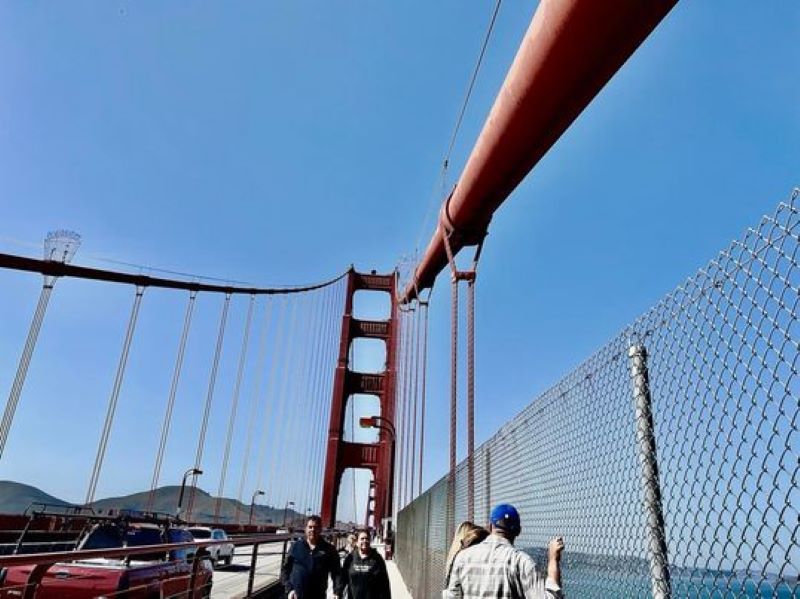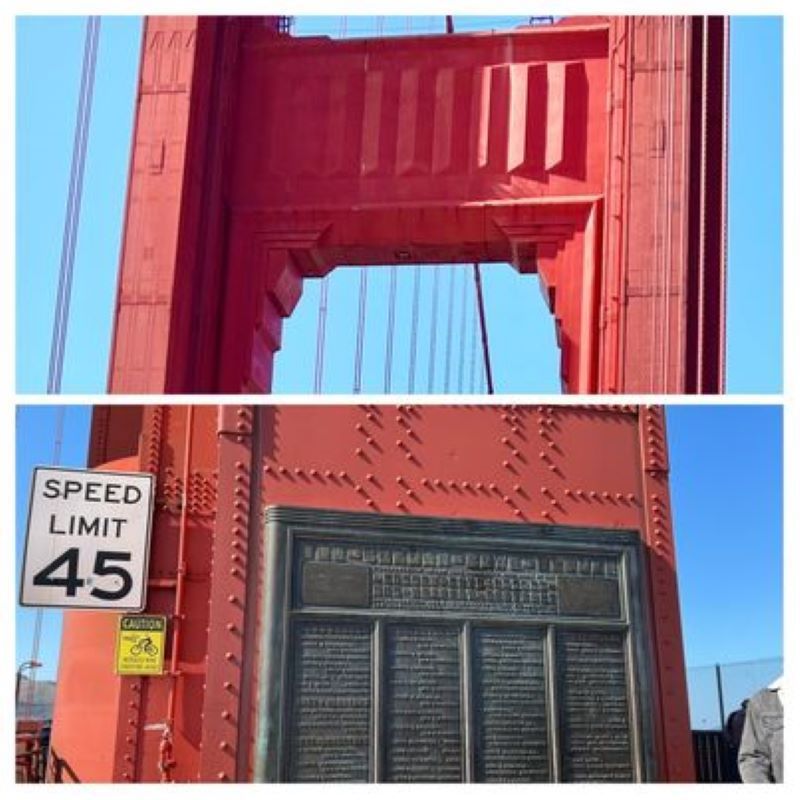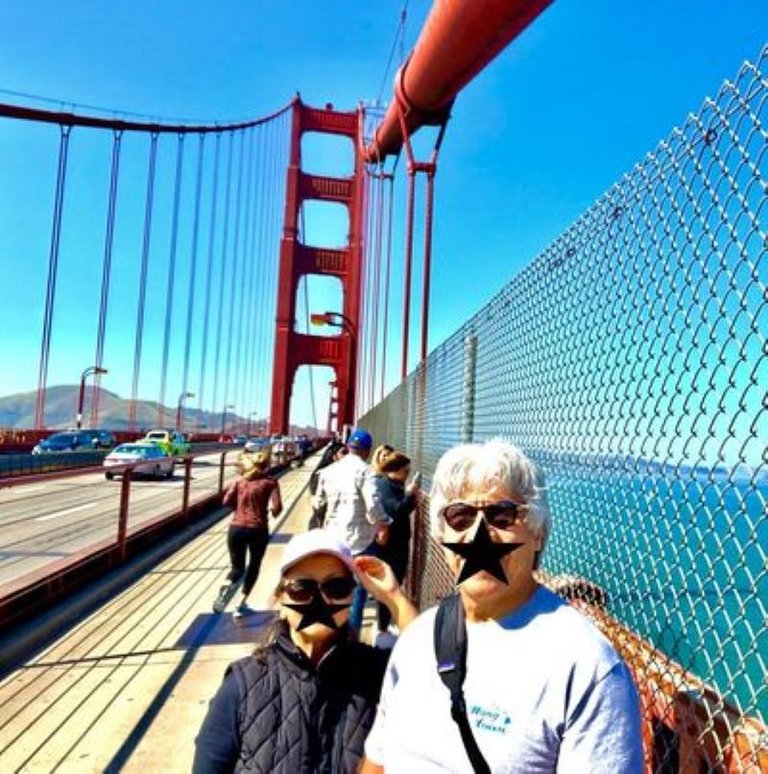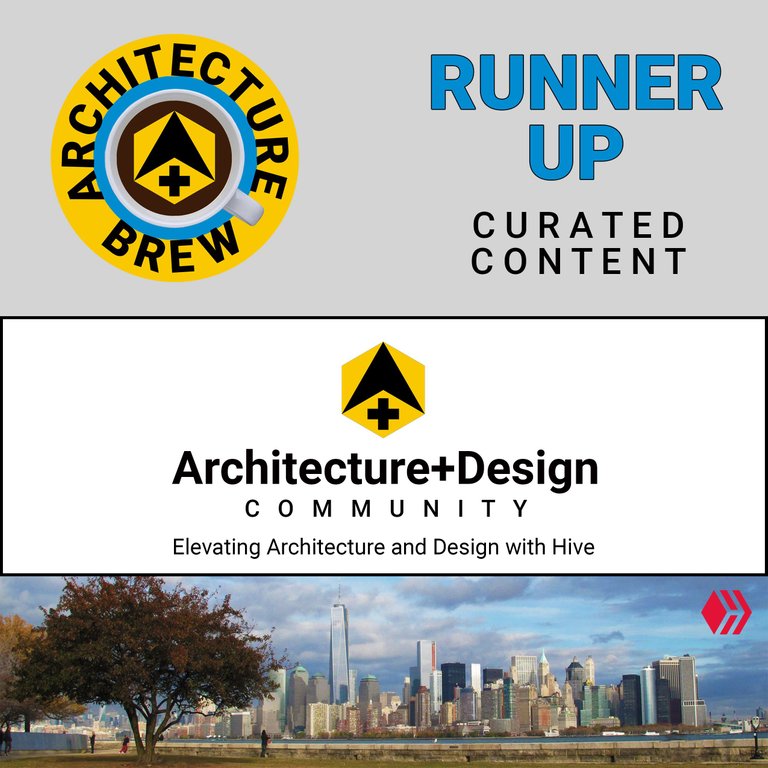
It’s very easy to fall in love with charming San Francisco, California. But it’s a long-distance love, a six-hour drive up to the north, through the California interstate freeway 5. Longer still, if you take the scenic route along the Pacific Coast. But SF beckons once in a while and so we come. Again and again. We cross the iconic Golden Gate Bridge, ride the cable cars, drive down hilly streets past gorgeous Victorian homes and savor the glorious clam chowder and seafood!
So today we went on this road trip starting from home in the morning and arriving at 3PM at the Golden Gate Bridge. Yes, our first stop is the Golden Gate Bridge. Usually, we go straight to the chowders, but today, the Bridge comes first. The chowder can wait. We parked the car by the Welcome Center and were pleasantly surprised - there was no parking fee today! Our lucky day!
We jumped out of the car and wasted no time in trying to get a clear first picture of the day, angling for a good view of the Bridge, but not before wading through a sea of people for that unobstructed view. Finally, we snapped a good one - the Golden Gate Bridge over blue waters, and in the background - a clear blue sky, none of that famous SF fog!

We took a load of pictures, and selfies of course, and from here, we planned to take a stroll along the bridge walkway before they close it to pedestrians by nightfall. We plan to walk only halfway - or less - of its 2-mile length, past the first tall tower.
AN ENGINEERING FEAT
The Golden Gate Bridge in San Francisco’s architectural gem, said to be an engineering marvel, was built during the Great Depression. It is deemed to be one of the most photographed bridges in the world as it is a spectacular 2-mile bridge with two 750-foot-tall towers, gorgeous Art Deco elements, ‘sweeping main cables, and a unique vibrant color called ‘International orange’.

The Golden Gate Bridge is a suspension bridge, where the roadway deck is suspended by main cables that pass over the top of tall towers, which support most of the bridge’s weight. Connected to these main cables are smaller vertical cables called suspenders, that pull the weight of the roadway to the main cables. The main cables are then secured to an anchorage at each end of the bridge. A truss system under the roadway deck stabilizes the bridge and reduces its tendency to sway.


Here’s a close-up picture of one of the Golden Gate bridge’s main suspension cables. It’s about three feet thick in diameter and weighs 12,000 tons, It is made of galvanized carbon steel wire bound tightly together.

Here are the vertical suspenders; each suspender rope is more than two inches thick in diameter.


This is one of two tall towers on the bridge; its height is 750 feet above the water and 500 feet above the roadway. It was designed with Art Deco elements.

Each tower in the bridge has approximately 600,000 of these rivets.

This is the concrete Anchorage at the south end of the bridge.
The original concept of the Golden Gate Bridge was conceived by architect Joseph Strauss. It was his dream to build a bridge over the Golden Gate, the narrow strait that connects San Francisco Bay to the Pacific Ocean. His design though was later replaced by a suspension bridge, which was proposed by other engineers in his team. Irving Morrow, one of the later architects, added the graceful Art Deco detailing in the towers, the street lamps, and railings. He also decided on the color dubbed ‘International orange’ color. It was built in four years and opened to the public in 1937. Upon its completion, the Golden Gate Bridge was the longest and tallest suspension bridge in the world.

Stone signage honoring architect Joseph Strauss in “Men of Vision”
"THE MIGHTY TASK IS DONE"
Joseph Strauss was not only an engineer and architect. Apparently, he was also a poet. Upon completion of the Golden Gate Bridge, he wrote a beautiful poem of the above title. Here’s an excerpt from the goldengate.org
WALKING ON THE BRIDGE
We strolled northbound along the Golden Gate Bridge along a walkway on the east sidewalk. Braving the cold and the wind - yes, it was windy which made it more chilly - we entered the bridge from the south end, the city of San Francisco (the north end is Marin county). A few pedestrians were walking with us - some in the same direction, others in the opposite. We also had to dodge a few bicycle riders. It’s always fun to walk here, suspended between the ocean and the sky, the wind fluttering in your face. It’s an exhilarating experience!

This is on the bridge walkway, with the main cable hanging over us; part of the bridge is fenced off for safety.

Getting close to the south tower, with vertical suspenders in the backdrop.

Still on the bridge, next to vertical suspenders with the city of San Francisco and the Bay in the background.

A snapshot of the railings, SF City, and the water below. Looking down kind of gave me butterflies in the stomach.

So we reached the 750-ft South tower. Yup, it is tall!

Past the south tower were these Art Deco street lamps! They light up the bridge beautifully at night. There’s the north tower far in the background.
We were getting close to the middle of the bridge and I could feel the bridge vibrate when cars passed by! Scared me a little so I had to hold on to the railings for support. Not much later, we decided to turn back. We made a few more stops and took more pictures, of course. At the foot of the bridge, we took the return route passing by the adjacent Bridge Plaza which had some interesting displays.

The street signage shows the direction of the bridge walkway and the Bridge Plaza
We snapped a few more pictures as we got farther away from the bridge and on towards the Plaza.





At the Plaza, there was a model of a suspension bridge; kids were having fun tugging at the cables.

An interactive screen shows a picture of the bridge under construction between 1935 and 1937.
BRIDGE VIEW FROM THE HILLS
There is a famous vista point up on the hill which is an even better spot to view the Bridge. So back to the car, we drove up through narrow and winding roads and got to the place called Hawk Hill. Because of its high vantage point, it was a perfect spot for a panoramic view of the bridge.

Beautiful panorama of the Golden Gate Bridge from Hawk Hill
We also drove down to the Battery Spencer, another popular vantage point of the Bridge from the west side. It was definitely colder and windier up here. But it was beautiful!


By contrast, below were some of the shots we took a few years back. It was also summertime, but it was close to sundown and the SF fog has rolled in. The pictures are a lot dimmer.


CLAM CHOWDER HERE WE COME!
Leaving the bridge behind, we drove to Fisherman’s Wharf in anticipation of that warm clam chowder that we have come here for the nth time. To our amazement and great sadness, our go-to restaurant has been closed, dark, and padlocked! So is the whole row of restaurants next to it. They closed at the height of the COVID-19 pandemic and did not survive. Only the bigger ones did. Sooo sad!

We did get our clam chowder alright. Served warm in sourdough bread at Boudin restaurant, it was good but did not quite taste as savory as in years past. (Biased? ) But we enjoyed the appetizers - crispy fried calamari - and the drinks.


So all is well that ends well!
Tomorrow we’ll visit San Francisco’s Victorian homes in the ‘Postcard Row’, also called the Seven Painted Ladies. We’ll tell you all about it in a future post.
Thanks for the read guys. Have a nice day!
[//]:# (!pinmapple 37.820574 lat -122.451709 long golden gate bridge d3scr)


